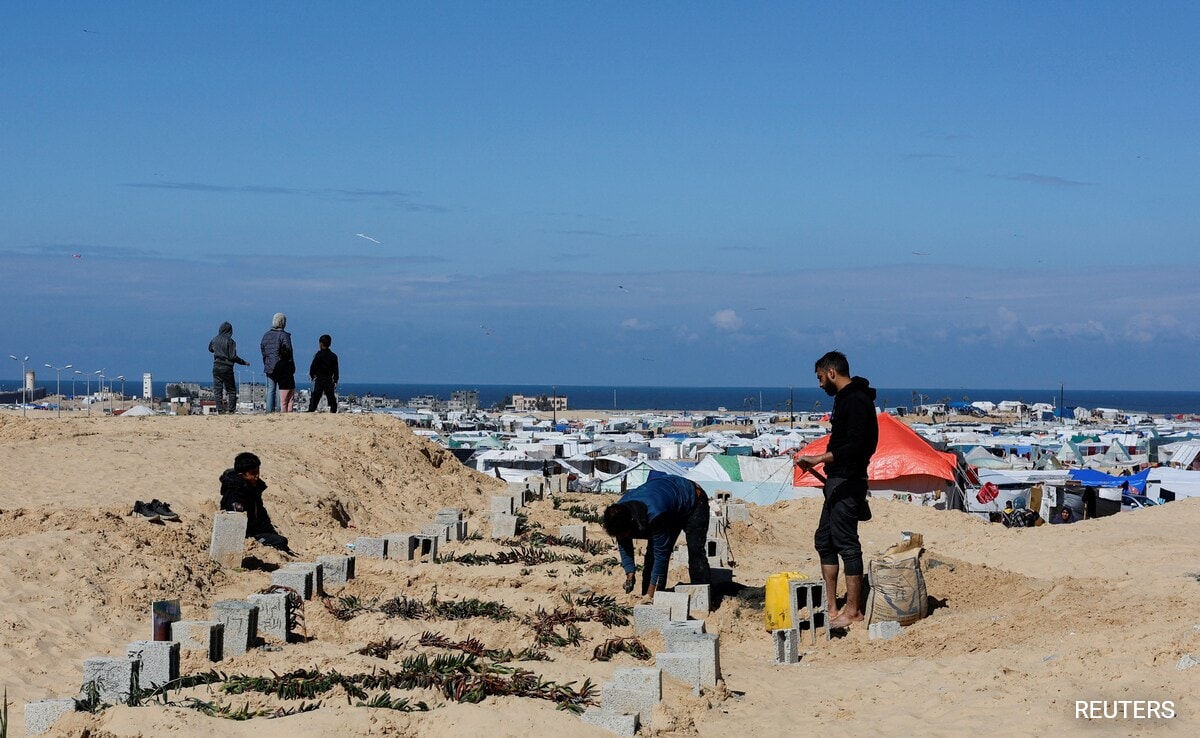2024-02-06 12:56:19

More than half of Gaza’s 2.3 million people are now hemmed into Rafah. (File)
Rafah:
Displaced again and again by Israel’s military offensive on Gaza, Mahmoud Amer and his family have now pitched their tent close to gravestones in a cemetery in Rafah, the last place of relative safety in the ruined strip of land.
The family are among dozens camping in the cemetery, a sandy expanse with a view of the Mediterranean Sea on the horizon, because they feel less at risk there from Israeli bombardments.
“People were forced to come here to this safe place, which is the cemetery among the dead,” said Amer, who is displaced from Al-Shati refugee camp in northern Gaza with 11 family members including children and grandchildren.

Displaced Palestinians, who fled their houses due to Israeli strikes, shelter in a cemetery, in Rafah in the southern Gaza Strip.
“It’s better than living in residential areas where the houses could collapse on our heads,” said Amer, who spent weeks in other locations as the family gradually made their way southwards, fleeing Israel’s advance.
More than half of Gaza’s 2.3 million people are now hemmed into Rafah, on the southern edge of the enclave by the fence separating it from Egypt. Israel has threatened to storm the area with tanks when it finishes a battle in Khan Younis just north of it.
The cemetery has neat rows of low cement graves that pre-date the war, with plants and flowers growing on them, inscriptions and peeling paint.
It also has more rudimentary graves, those of people killed in the war: mounds of raised sand the length of bodies, with crude blocks of cement at each end.
“Every day, bodies are brought to be buried. We pray upon them and stay with them and ask for mercy for them,” said Amer.

A displaced Palestinian girl, who fled her house due to Israeli strikes, arranges plants on a grave in a cemetery where she shelters.
The lack of food and water and the constant fear of military attack were harrowing, said Amer.
“The dead are in comfort while we, the living, are in pain and going through very tough conditions. There is no water, no proper aid coming in, the situation is so bad,” he said.
Children were running in little groups between the rows of graves. One girl in a pink tracksuit sat on one of them picking small pink flowers and carefully filling an empty tin can with them.
“I see the children, our children, playing among and above the graves,” said Amer.
“This has become our life, all about death. Even while walking now, we see death in front of our eyes every second.”
The war was triggered by operatives from the Palestinian Islamist group Hamas who invaded southern Israel on Oct. 7, killing 1,200 people and abducting 253, according to Israel.
Vowing to destroy Hamas and free the hostages, Israel has responded with an all-out military assault on Gaza that has killed more than 27,000 people, according to local health officials.
(Except for the headline, this story has not been edited by NDTV staff and is published from a syndicated feed.)
Israel hamas War,Israel Hamas Gaza Palestine War,Israel Gaza attack,Israel Hamas,Israel Hamas Attack,Israel Hamas Ceasefire,Israel Hamas ceasefire ends,Israel Hamas Ceasefire Updates,Israel Hamas Ceasefire News,israel hamas attacks,israel hamas deal for hostages,Israel Hamas death count,Israel Hamas Gaza,Israel hamas deaths,israel hamas gaza palestine
Source link
![]()



